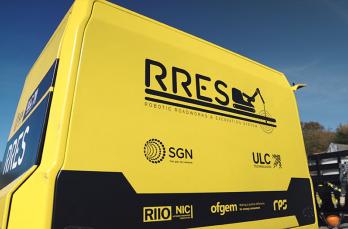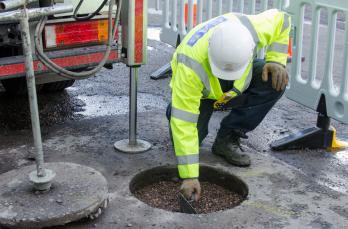A robotic roadworks system which could revolutionise the way roadworks are carried out in the UK is being trialled in Epsom, Surrey.
The Department for Transport estimates that 2.5 million roadworks are carried out in England each year. Aside from the obvious delays, they cause pollution from heavy machinery and traffic queues, and can be dangerous for engineers digging below the surface of roads around cables and pipes.
UK gas company SGN teamed up with New York-based robotics experts ULC Technologies to come up with a solution. Following three years of development and funding from energy regulator Ofgem, The Robotic Roadworks and Excavation System, or RRES for short, has been created. It’s an all-electric autonomous robot which can carry out the entire end-to-end excavation process.
The robot was unveiled to stakeholders from across the country today ahead of its first trial in the UK – on SGN’s gas network in Epsom, Surrey.
SGN Head of Innovation John Richardson said: “Typically, accurate robotic systems are found inside protected and controlled environments. RRES takes this technology into the field, mounting a robotic arm on a track to make the system mobile. It will help reduce risks to our engineers while providing them with new skills and state-of-the-art equipment.
“Any industry which needs to scan below ground and carry out deep excavations will benefit from RRES, including other utility companies and the construction and development sector. At SGN, we can potentially reduce the time taken for a typical gas repair job from days to hours, which is great news for our customers, colleagues and the environment.”
ULC Technologies Director of Infrastructure Automation and AI, Ali Asmari said: “Using a robotic arm on a mobile platform in an excavation environment will allow RRES to improve efficiency and worker safety by automating parts of the operation. The precision and repeatability of the robotic arm will provide highly accurate data to locate below ground assets and will help to identify the most strategic location to cut a keyhole excavation.”
SGN and ULC Technologies hosted stakeholders from Transport for London (TfL), other UK utilities and construction companies at their former gas holder station this week, to see the robot put through its paces. Transport for London Work Assessment Manager Lisa Hatt said: “SGN and ULC have led on innovation with TfL before, so it’s really good to continue on the journey of innovation with RRES. I think there will be a real respect for the technology moving away from the more traditional methods. We’re always looking for ways in which we can reduce the impact of roadworks, noise and pollution and I think RRES really encompasses all of that.”
Equipped with a concrete cutting chainsaw, RRES can cut any shape into a road surface. It does this by sensing the hardness of the surface and adjusting the cutting speed and strength of the chainsaw. This is ground-breaking (excuse the pun) for SGN which has been developing a keyhole strategy for excavations in recent years. Keyhole excavations allow SGN to carry out their operations from above ground using specialist tooling, significantly reducing the size of the excavation needed. The piece of road which is cut out can then be put back into the road at the end of the operation, helping SGN to reduce waste sent to landfill.
Utility excavations require multiple vehicles, heavy equipment and numerous teams. Since RRES is autonomous and can carry out the entire excavation process, it has a much smaller physical and carbon footprint. This, combined with using smaller keyhole excavations, will minimise the traffic management required for roadworks, reducing carbon emissions and delays.
Over 60,000 accidental utility strikes take place annually in the UK, potentially causing service disruptions, serious damage and injury. To help prevent this, RRES can scan below ground using artificial intelligence to map underground pipes and cables before any digging takes place.
It also uses supersonic air nozzles to agitate the soil, which is then removed with vacuum suction. The tool head uses sensors to detect any asset close to it avoiding damage and keeping field teams safe.




